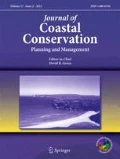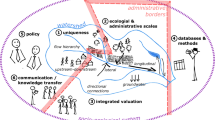Abstract
Stressor gradients and spatial narratives of the St. Louis River Estuary, a joint Minnesota and Wisconsin Sea Grant study, connected aquatic science research with spatially-explicit stories of local resource issues and place-based geo-quests to enhance spatial awareness and stewardship of the estuary. The goal of this paper is to report and reflect on an integrated study that combined environmental humanities and technology with aquatic science in a spatial context. Our study was organized into three objectives around research, outreach, and evaluation. First, we summarized anthropogenic stressors within high resolution watersheds and linked the watershed stress estimates to aquatic habitats within the estuary. Second, we designed tools to deliver place-based environmental science and technology to targeted users to increase awareness, learning, and the potential for long-term stewardship. And third, we evaluated the responses of targeted end users to their interaction with the project’s integrated science and innovative delivery methods. Finally, central to all three objectives, we created a dynamic website to facilitate regional to national coastal outreach and education goals. We found significant correlations between the stressor index and the water quality and biotic data, along with variability attributed to landscape elements. Connecting this science with the place-based experiences we collected is expected to expand the scope and reach of state, bi-national and non-governmental outreach programs. The project also has direct applications to classroom science education. Developing this integrated project contributed to our shared knowledge of environmental and cultural aspects of the estuary for place-based education, and offers several lessons for future work of this nature.








Similar content being viewed by others
References
Ameel J, Ruzycki E, Owen CJ, Axler R (1998) Analytical chemistry and quality assurance procedures for natural water, wastewater, and sediment samples (revised 2012). Natural Resources Research Institute, Duluth, NRRI/TR-98/28
AMS (2014) Earth system science, technology, engineering, and mathematics education: A policy statement of the American Meteorological Society. https://www.ametsoc.org/POLICY/2014Earth_STEM_Education.html. Accessed 26 Feb 2015
Apitz SE (2012) Conceptualizing the role of sediment in sustaining ecosystem services: sediment-ecosystem regional assessment (SEcoRA). Sci Total Environ 415:9–30
Ardoin NM, Schuh JS, Gould RK (2012) Exploring the dimensions of place: a confirmatory factor analysis of data from three ecoregional sites. Environ Educ Res 18(5):583–607
ASTE (2015) ASTE Position Statement on Technology in Science Teacher Education. http://theaste.org/about/aste-position-statement-on-technology-in-science-teacher-education/. Accessed 26 Feb 2015
Bartsch WM (2012) Relationship between water quality and anthropogenic landscape stressors in the St. Louis River watershed and estuary. M.S. Dissertation, Water Resources Science, University of Minnesota-Duluth. 77p
Bartsch WM, Axler R, Host G (2015) Evaluating a Great Lakes scale landscape stressor index to assess water quality in the St. Louis River Area of Concern. J Great Lakes Res 41:99–110
Berndt ME, Bavin TK (2012) Methylmercury and dissolved organic carbon relationships in a wetland-rich watershed impacted by elevated sulfate from mining. Environ Pollut 161:321–327
Bodenhamer DJ, Corrigan J, Harris TM (2010) The spatial humanities: GIS and the future of humanities scholarship. Indiana University, Bloomington
Bourdaghs M, Johnston CA, Regal Rr (2006) Properties and performance of the Floristic Quality Index in Great Lakes coastal wetlands. Wetlands 26(3):718–735
Brown G, Raymond C (2007) The relationship between place attachment and landscape values: toward mapping place attachment. Appl Geogr 27(2):89–111
Brown TN, Host GE, Johnson LB (2011) Lake Superior Sediment Assessment. NRRI/TR-2011/35, Natural Resources Research Institute, U. of Minnesota, Duluth, MN 55811, 1–32
Brown G, Raymond CM, Corcoran J (2015) Mapping and measuring place attachment. Appl Geogr 57:42–53
Chawla L (1999) Life paths into effective environmental action. J Environ Educ 31(1):15–26
Danz N, Regal R, Niemi G, Brady V, Hollenhorst T, Johnson L, Host G, Hanowski J, Johnston C, Brown T, Kingston J, Kelly J (2005) Environmentally stratified sampling design for the development of Great Lakes environmental indicators. Environ Monit Assess 102:41–65
Danz N, Niemi G, Regal R, Hollenhorst T, Johnson L, Hanowski J, Axler R, Ciborowski J, Hrabik T, Brady V, Kelly J, Morrice J, Brazner J, Howe R, Johnston C, Host G (2007) Integrated measures of anthropogenic stress in the U.S. Great Lakes basin. Environ Manag 39:631–647
Davenport MA, Anderson DH (2005) Getting from sense of place to place-based management: an interpretive investigation of place meanings and perceptions of landscape change. Soc Nat Resour 18(7):625–641
Fortner RW, Corney JR (2001) Great lakes educational needs assessment: teachers priorities for topics, material & training. J Great Lakes Res 28(1):3–14
Fortner RW, Meyer RL (2000) Discrepancies among teachers’ priorities for and knowledge of freshwater topics. J Environ Educ 31(4):51–53
Gagnon D (2010) ARIS: An open source platform for developing mobile learning experiences. Thesis, University of Wisconsin-Madison. 59 pages
Gilbert L, Sandberg L, Wekerle G (2009) Building bioregional citizenship: the case of the Oak Ridges Moraine, Ontario, Canada. Local Environ: Int J Justice Sustain 14(5):387–401
Graham EA (2011) Using mobile phones to engage citizen scientists in research. Eos Trans Am Geophys Union 92(38):313–314
Halpenny EA (2010) Pro-environmental behaviours and park visitors the effect of place attachment. J Environ Psychol 30(4):409–421
Hart D (2014) Stressor Gradients and Spatial Narratives of the St. Louis River Estuary: Open Archives for Accessing the Science of the Estuary. http://maps.aqua.wisc.edu/geocatalog/pdf/slre-archive-dhart.pdf. Accessed 6 Mar 2015
Host GE, Schuldt J, Ciborowski JJH, Johnson LB, Hollenhorst T, Richards C (2005) Use of GIS and remotely sensed data for a priori identification of reference areas for Great Lakes coastal ecosystems. Int J Remote Sens 26:5325–5342
Host GE, Brown TN, Hollenhorst TP, Johnson LB, Ciborowski JJH (2011) High-resolution assessment and visualization of environmental stressors in the Lake Superior basin. Aquat Ecosyst Health Manag 14:376–385
JMP (2011) Version 9. SAS Institute Inc., Cary, pp 1989–2011
Johnson RM, Gardiner S, Henderson L, Russell R, Ward D, Foster S, Meymaris K, Hatheway B, Carbone L, Eastburn T (2008) Lessons learned through our climate change professional development program for middle and high school teachers. Phys Geogr 29(6):500–511
Kim C, Fortner RW (2008) Great Lakes scientists’ perspectives on K-12 education collaboration. J Great Lakes Res 34(1):98–108
Luisetti T, Turner RK, Jickells T, Andrews J, Elliott M, Schaafsma M, Beaumont N, Malcolm S, Burdon D, Adams C, Watts W (2014) Coastal zone ecosystem services: from science to values and decision making; a case study. Sci Total Environ 493:682–693
Lukacs HA, Ardoin NM (2014) The relationship of place re-making and watershed group participation in Appalachia. Soc Nat Resour 27(1):55–69
Moller-Jensen L, Jeppesen H, Kofie RY (2008) GIS-facilitated spatial narratives: Danish plantations in Ghana. Geogr Tidsskri-Dan J Geogr 108(2):49–57
Monroe MC (2003) Two avenues for encouraging conservation behaviors. Hum Ecol Rev 10(2):13
MPCA (2009) Surface water assessment grant quality assurance project plan, February 2009. Minnesota Pollution Control Agency, St. Paul, 55155
MPCA (2013) St. Louis River St. Louis River Area of Concern Implementation Framework: Roadmap to Delisting (Remedial Action Plan Update) July 15, 2013. Minnesota Pollution Control Agency, Duluth, MN 55802. http://www.pca.state.mn.us/index.php/water/water-types-and-programs/surface-water/st.-louis-river-area-of-concern.html#resources. Accessed 3 Mar 2015
NERR (2007) System-wide monitoring program (SWMP): a scientific framework and plan for detection of short-term variability and long-term change in estuaries and coastal habitats of the United States. National Estuarine Research Reserve
Nieber, JL, Arika, C Hansen, B (2013). Lower Poplar River Watershed Sediment Source Assessment. U. of Minnesota, Department of Bioproducts and Biosystems Engineering University of Minnesota. Prepared for the Minnesota Pollution Control Agency, original submission, August 2011, finalized February 2013
NOAA (2010) Lake Superior National Estuarine Research Reserve Management Plan. Superior, WI. University of Wisconsin Extension Services. www.nerrs.noaa.gov/Doc/PDF/Reserve/LKS_MgmtPlan.pdf. Accessed 3 Mar 2015
NOAA (2013) The National Coastal Zone Management Program Measuring Performance: Community Development. http://coast.noaa.gov/czm/media/czmperfcomdevel.pdf. Accessed 6 Mar 2015
NRCS SSURGO (2012) U.S. Department of Agriculture Natural Resources Conservation Service Soil Survey Database: www.nrcs.usda.gov/wps/portal/nrcs/detail/soils/survey/?cid=nrcs142p2_053627. Accessed 3 Mar 2015
Oxx K, Brimicombe A, Rush J (2013) Envisioning deep maps: exploring the spatial navigation metaphor in deep mapping. Int J Humanit Arts Comput 7(1–2):201–227
Palmer JA, Suggate J (1996) Influences and experiences affecting the pro-environmental behavior of educators. Environ Educ Res 2(1):109–121
Pike K, Wright P, Wink B, Fletcher S (2014) The assessment of cultural ecosystem services in the marine environment using Q methodology. J Coast Conserv 1–9
Ridge M, Lafreniere D, Nesbit S (2013) Creating maps and spatial narratives through design. Int J Humanit Arts Comput 7(1–2):176–179
Roth RE, Harrower M (2008) Addressing Map interface usability: learning from the lakeshore nature preserve interactive Map. Cartogr Perspect 60(1):21
Seelbach, PW, Read, JG, Buckner, KA, Eder, T, Manninen, C. (2014) Great Lakes Blue Accounting: Empowering decisions to realize regional water values. A report to the Council of Great Lakes Governors, in response to the Governors’ 2013 resolution on water monitoring. March 28
Seifert J, Shaw B (2013) Tending our patch of creation: engaging Christians in environmental stewardship through sense of place. J Stud Relig Nat Cult 7(3):265–288
Silbernagel J (2005) Bio-regional patterns and spatial narratives for integrated landscape research and design. In: Tress B, Tress G, Fry G, Opdam P (eds) From landscape research to landscape planning: aspects of integration, education, and application. Wageningen UR frontis series, 12th edn. Springer, Dordrecht, pp 107–118
Silbernagel J (2013) Coastal communities create their story through Spatial Narrative Geotools. Proceedings, Esri User Conference, July, San Diego
SLRCAC (1992) The St. Louis River System Remedial Action Plan Stage One. St. Louis River Citizens Action Committee, Duluth, MN. http://www.stlouisriver.org/remedial-action-plan/. 4 Mar 2015
SLRCAC (2002) Lower St. Louis River Habitat Plan. St. Louis River Area of Concern Citizen Action Committee, Duluth, MN. http://www.stlouisriver.org/documents/. 4 Mar 2015)
Smith, VM (2007) Growing our own: the socioeconomic value of community food production. Dissertation. University of Wisconsin-Madison. Madison, WI
Smith VM (2008) Environmental belief formation in children. VDM Verlag, Berlin, pp 114–118
Stern PC (2000) Toward a coherent theory of environmentally significant behavior. J Soc Issues 56(3):407–424
Thayer RL (2003) LifePlace: bioregional thought and practice. University of California Press, Berkeley
USEPA (2013) St. Louis River & Bay Area of Concern. Great Lakes National Program Office, U.S. Environmental Protection Agency, http://www.epa.gov/greatlakes/aoc/stlouis/index.html#rap_info. Accessed 20 Jun 2013
USGS (2004) National field manual for the collection of water-quality data: U.S. Geological Survey Techniques of Water-Resources Investigations, Book 9, chapters A1-A9, http://pubs.water.usgs.gov/twri9A. Accessed 3 Mar 2015
Uzarski DG, Brady VJ, Cooper M (2012) Quality assurance project plan: great lakes indicator consortium (GLIC): implementing great lakes coastal wetland monitoring. Prepared for U.S. EPA GLNPO, Chicago
Wagler M, Mathews J (2012) Up river: place, ethnography, and design in the St. Louis river estuary. In: Dikkers S, Martin J, Coulter B (eds) Mobile media learning: amazing uses of mobile devices for teaching and learning. ETC Press, Pittsburgh
Walker RD, Pastor J, Dewey B (2010) Litter quantity and nitrogen immobilization cause oscillations in productivity of wild rice (Zizania palustris L.) in northern Minnesota. Ecosystems 13:485–498
Acknowledgments
This work was supported primarily by a joint Minnesota and Wisconsin Sea Grant Institute (NOAA) project. This work was funded by the University of Wisconsin Sea Grant Institute under grants from the National Sea Grant College Program, National Oceanic and Atmospheric Administration, U.S. Department of Commerce, and from the State of Wisconsin. Federal grant number NA100AR4170070, project number R/RegHCE-08-10. The Minnesota Sea Grant portion of the project was funded under grant number R/RegHCE-8-10.
Our team also had extensive in-kind support from the University of Minnesota-Duluth Natural Resources Research Institute, the University of Wisconsin-Madison, and the Minnesota and Wisconsin Sea Grant Institutes. We would especially like to acknowledge J. Reed (Red Pebble Web Design) for website design.
In addition, we wish to acknowledge supporting contributions by: M. Anderson, T. Brown, P. Collins, D. Desotelle, D. Erickson, R. Garono, R. Greene, J. Henneck, J. Hoffman, T. Hollenhorst, A. Moser, J. Karl, P. Meysembourg, E. Ruzycki, J. Schomberg, J. Schuldt, G. Sjerven, N. Will, J. Zomerfelt
Author information
Authors and Affiliations
Corresponding author
Rights and permissions
About this article
Cite this article
Silbernagel, J., Host, G., Hagley, C. et al. Linking place-based science to people through spatial narratives of coastal stewardship. J Coast Conserv 19, 181–198 (2015). https://doi.org/10.1007/s11852-015-0380-1
Received:
Revised:
Accepted:
Published:
Issue Date:
DOI: https://doi.org/10.1007/s11852-015-0380-1




